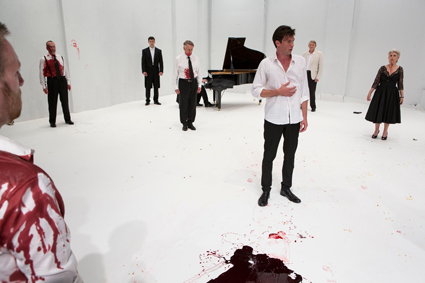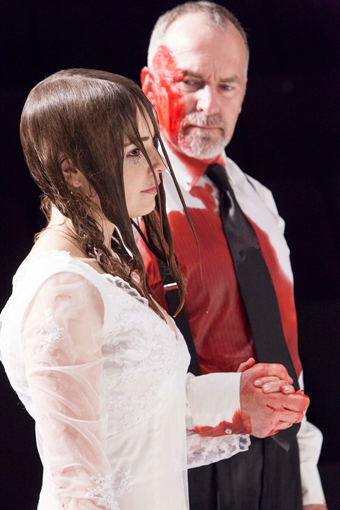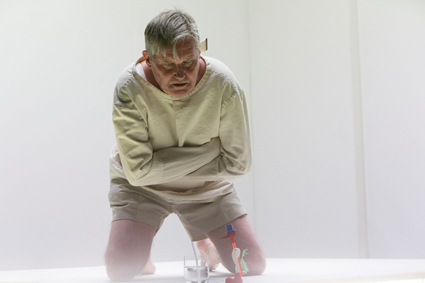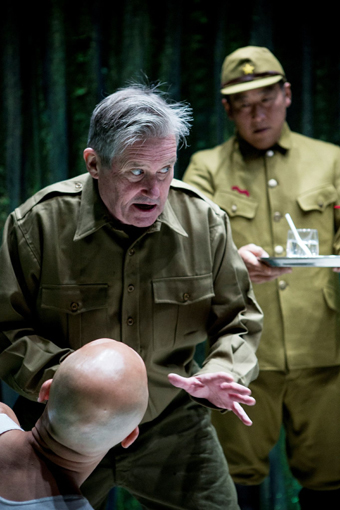Hamlet, Harding & the Living Dead
Keith Gallasch: Belvoir, Hamlet; Griffin, The Floating World

Toby Schmitz and cast of Hamlet, Belvoir
photo Brett Boardman
Toby Schmitz and cast of Hamlet, Belvoir
Harrowed, again. Having recuperated from The Maids, Persona and Angels in America (RT116), ), I found myself sucked into the vortices of madness that are Shakespeare’s Hamlet and Les Harding in John Romeril’s The Floating World in chillingly intimate productions from Belvoir and Griffin.
‘Hamlet mad or not’ has long been a subject of debate, but if ‘seeing things’ is a criterion for treatment then the Simon Stone-Toby Schmitz rendering places the prince firmly in the madhouse. His father’s ghost (Anthony Phelan) is a very palpable presence from the word go, dapperly attired in white dinner jacket, open necked white shirt and black trousers, confronting and later hugging his son and assuming the words of a gone-missing Gravedigger. As ever the stage at the end of Hamlet is littered with bodies poisoned and stabbed, but [spoiler alert] in Stone’s economised version—no sword fight, no suspense, just a kind of reportage, oscillating between then and now—the dead (including Polonius, a dripping Ophelia and the late king) stand about bleeding from their wounds, evoking no less than the Living Dead so beloved of contemporary popular culture. It’s a striking image, if grimly funny, and not altogether legible for those unfamiliar with Shakespeare’s emotionally exhausting, protracted ending.
Nor is it bumping into his father’s ghost that triggers Hamlet’s drive for vengeance. We arrive in the theatre to find him already darkly attired, perched on the edge of a chair in a state of palpable high anxiety—frowning, cheeks flushed, agitated. Blackout. Lights up—Ophelia is already in his lap. Blackout. And off we go. As with the ending, the cutting and pre-determining at the beginning feel reductive and impatient; as does the thinning out of Hamlet’s world. Horatio and others are gone, their functions briefly embodied in an anonymous figure; Laertes is rendered less significant (if finely performed by Thomas Campbell); and no Fortinbras comes to assume power after the self-destructive carnage enacted by this state. Stone’s version of Hamlet transforms it into a brisk chamber play focused overtly on the prince and, as the director did with The Wild Duck, erases the wider world Hamlet inhabits and, with it, complexities of power, role and class. Shakespeare saw the world in larger terms.
Although irritated by Stone’s ‘digest’ of Hamlet, I found enough power in the production and strengths in the performances to make for an often immersive experience. The dark curtained walls, the surrounding rows of functional chairs, a grand piano, the neat rows of designer lighting above with their almost sepia glow over an otherwise empty space, suggested a funeral parlour and, with Hamlet and his father (seated the other side of the room) casually suited, not unlike, say, the seductively smooth black and white ambience of Le Feu Follet, Louis Malle’s 1963 film about a suicidal alcoholic. The stage design evoked a time not quite our own: a not far off past, confirmed with the playing from Erik Satie’s Gnossiennes at the beginning and a countertenor in tails crossing the stage from time to time singing laments from various periods, as if at a soiree. After interval, Hamlet rolls about on an Eames chair, the stage now starkly white—no more darkness, no more secrets.

Emily Barclay, Greg Stone, Hamlet, Belvoir
photo Brett Boardman
Emily Barclay, Greg Stone, Hamlet, Belvoir
Schmitz’s Hamlet is equally introvert and extrovert, jokily engaging with the audience, hugging his father’s ghost and openly weeping, leaning over the seating balustrade to deliver “To be or not to be…” directly to us, none too anxiously, while elsewhere flattening the beat in “O that this too, too solid flesh would melt” or breaking the rhythms of lines to suggest an interiority barely in touch with the words he utters. There’s just enough legato to keep the poetry intact and emotionally engaging. Hamlet’s complexity is brought home in Schmitz’s seamless blending of deep-seated despair and indecision—realised not only verbally but with a racking, intense physicality—and wicked calculation played to the audience.
Claudius (John Gaden) in double-breasted suit and Gertrude (Robyn Nevin) in black bejewelled gown come across as an older, more formal generation, their neat, classical diction aptly tested by the anger and anguish that erupts from them in the crises they find themselves as if not believing them to be of their own making. Greg Stone, a not at all elderly, business-like Polonius, deftly, amusingly and movingly delivers his lines as if of a generation between Hamlet and his parents. Emily Barclay’s Ophelia is painfully sweet and therefore all the more victim of Hamlet’s escalating “get thee to a nunnery” rant. Unfortunately the pathos of the mad Ophelia’s (none too tuneful) singing is undercut by atonal piano tinkling.
I was surprised to hear Schmitz’s Hamlet groan as he cradled the dead Ophelia and howl at the play’s bloody climax, as did some of the living dead standing about him who then united in song as Hamlet shook and cried aloud. I know Olivier famously yowled at the end of a production of Oedipus Rex, but I’ve always felt there is enough power in the poetry of Shakespeare to not warrant such additions. Here a bit more silence before (and after) “The rest is silence” would have been welcome. Just prior to the singing, the Ghost had uttered Horatio’s “Goodnight sweet prince” confirming what we sensed from the beginning, that this production of Hamlet was to be a father-son psychodrama in which, above all, Hamlet’s guilt is writ large at the end, on a stage populated by the dead, including Hamlet himself—a veritable purgatory of existential angst. This made for a rather heavy-handed and less than cathartic Hamlet, leaving us bereft of that peculiarly disturbing and comforting Shakespearean dialectic of existential horror on the one hand and a sense on the other of completion, a return to some kind of order, even if flawed. This is a Hamlet well worth seeing, to enjoy and quarrel with.

Peter Kowitz, The Floating World, Griffin Theatre Company
photo Brett Boardman
Peter Kowitz, The Floating World, Griffin Theatre Company
The Floating World
In John Romeril’s delirious cabaret of derangement, The Floating World (1974), a World War II Australian soldier who has witnessed first hand the atrocities perpetrated by the Japanese army, is on a Women’s Weekly Cherry Blossom cruise to Japan many years later. Les Harding (Peter Kowitz) is unhappy to be dragged away from the comforts of home but it simply hasn’t occurred to him that this trip might become a voyage into the past, let alone madness. His wife, a fellow passenger and the ship’s staff witness Les’s angry decline and are implicated in it, becoming projections for figures from his past. In effect Les becomes our shipboard entertainment, supplanting the crudely offensive MC with his own stream of racist and sexist wisecracks and increasingly offensive limericks which casually at first and then frantically keep nasty memories and unwelcome intimacy at bay.
Les, as with many generations of soldiers, has kept his war memories to himself, above all never speaking about feeling guilty for having survived when friends died in appalling circumstances. His defence mechanisms gradually break down, paranoia and hallucinations ensue—an Asian waiter is fantasised to be a Japanese soldier whom Les beats. Director Sam Strong and actor Peter Kowitz finely shape Les’s collapse as an increasingly intense, angry and bewildered descent into madness with fewer and fewer moments of respite. We see it coming before his companions do. Initially it’s just the sort of bad behaviour that his tolerant wife expects from Les, especially when he drinks. But by Act 2 his cruel treatment of her, triggered by unwarranted sexual jealousy, and his conversations with the dead signal a man deeply traumatised, punishing others as well as himself for the guilt he feels. The truth comes out in an enormous, painful rush, a raw soliloquy that relives horrendous experiences. Although resisting—protecting himself with a fresh barrage of limericks—he gets through his story in an internal reparation, which we hope he can translate into his relationship with his wife, friends and the Japanese.
Kowitz, in doubtless the best performance of his career, embodies all the complexities of Les, an apparently ordinary man whose repressed memories have leapt forth in the shape of the living dead who can now, at last, be spoken of and put to rest, if never to be forgotten. There is little stillness in Kowitz’s astonishingly relentless physical realisation of Les, one matched by his verbal fireworks, doing full justice to John Romeril’s rich vernacular poetry. At the play’s end, Les, emerging as “a new man,” recalls an apparently small victory of survival after being kicked into a fire by a Japanese officer:
“They scraped me out—potatoes out of the embers. I stood there swaying as he rained blows on me. I didn’t feel a thing. In the corner a bottle of vitamin B tablets poked from the top of his pack—dance like palm trees in a mirage—flowers on a cloud […] I walked in a dream—the ghost of a shoplifter in Myers returning to the scene of the crime—time stopped for everyone but me. When they left that night, two-star Corporal Yomito lacked his vitamin B supply. I lived in a floating world.”

foreground Justin Stewart Cotta, Peter Kowitz, Shingo Usami, The Floating World, Griffin Theatre Company
photo Brett Boardman
foreground Justin Stewart Cotta, Peter Kowitz, Shingo Usami, The Floating World, Griffin Theatre Company
In Stephen Curtis’ aptly spare design a glittering showbizzy curtain curves behind a simple platform stage, opposite which is a keyboard for the ship’s entertainment officer. As in the second half of Simon Stone’s Hamlet, the curtain is whisked away to reveal stark white walls as madness becomes palpable and, finally, Les raves his way to salvation in a straitjacket. Sam Strong’s account is in every respect a powerful ensemble production: Valerie Bader is perfect as Irene Harding, used to casually deflecting her husband’s barbs, oblivious to her misuse of words (making her comic but no less sensitive) and now painfully confronted with a husband out of control. Tony Llewellyn-Jones is the amicable, gentlemanly former British officer whose tolerance of the abuse meted out by Les is stretched to near breaking point. Justin Smith’s comic is an aptly gross reflection of Les’s prejudices, but one without justification. Justin Stewart Cotta as ship’s musician and the long dead soldier mate McLeod is a strong, flexible performer, as is Shingo Usami as the put-upon waiter-cum-officer whose other job is to manipulate the Dippy (or Drinking) Bird (originally Chinese, then Japanese before being mass-marketed by the US)—that haunting symbol of balance and the absence of real autonomy—that Romeril employs between scenes. Kelly Ryall’s sound score is aptly eerie, resonant with the play’s many unsettling, floating signifiers, not least the reverberant title which ironically analogises the crude shipboard entertainment with Japan’s sophisticated cultural underworld and then Les Harding’s lost soul.
Save for a slightly stiff staging of the play’s final lines (delivered by three of the cast instead of two) this production of The Floating World is superbly unnerving, confirming once again that the play is indeed an Australian classic, a phrase tossed about too easily these days.
Ewen Leslie replaced Toby Schmitz as Hamlet from November 19.
The Floating World will play at Riverside Theatres, Parramatta, 19-23 Nov, http://riversideparramatta.com.au/show/the-floating-world/
Belvoir, Hamlet, writer William Shakespeare, director Simon Stone, designer Ralph Myers, costumes Mel Page, lighting Benjamin Cisterne, music, sound Stefan Gregory, Belvoir Theatre, 16 Oct-1 Dec; Griffin Theatre Company, The Floating World, writer John Romeril, director Sam Strong, The Stables, Sydney, 4 Oct-16 Nov
This article first appeared in RT’s online e-dition 13 November, 2013
RealTime issue #118 Dec-Jan 2013 pg. 38






